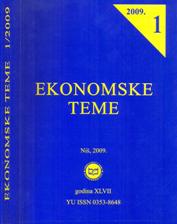Economic Themes (2009) 47 (1) 1, 1-46
Dragan Đuričin, Stevo Janošević
Abstract: This work analyzes the relevant aspects of strategic analysis of human resources. It starts with an analysis of the significance of this kind of resources for the obtaining of competative advantage. Special emphasis has been put on the analysis of the importance of learning and knowledge, as well as the role of human resources in the process of the management of changes. Since non-material assets influence the potential growth and increase of value of an enterprise, the author continues with the analysis of human capital as the most important part of non-material assets, following with the description of the specific nature of human resource management and the most important activities in this process: human resource planning, human resource recruitment, selection, development and eveluation of performance, as well as the maintenance of the effective work-force relationship. Bearing in mind that human resources cannot be considered outside the usual enterprise activities, since these activities determine the required resources and capabilities and, therefore, are directly related to the enterprise strategy, the author concludes this work with the analysis of the role of human resources in business strategy. Special attention is paid to three related issues: (1) influence of business strategy on human resource strategy, (2) using of the Balance Scorecard for defining and implementation of human resource strategy and (3) development of human resource competences.
Keywords: human resources; knowledge management; non-material asset; human capital; business strategy; Balanced Scorecard
THE STRATEGIC ANALYSIS OF HUMAN RESOURCES
Dragan Đuričin, Stevo Janošević
Abstract: This work analyzes the relevant aspects of strategic analysis of human resources. It starts with an analysis of the significance of this kind of resources for the obtaining of competative advantage. Special emphasis has been put on the analysis of the importance of learning and knowledge, as well as the role of human resources in the process of the management of changes. Since non-material assets influence the potential growth and increase of value of an enterprise, the author continues with the analysis of human capital as the most important part of non-material assets, following with the description of the specific nature of human resource management and the most important activities in this process: human resource planning, human resource recruitment, selection, development and eveluation of performance, as well as the maintenance of the effective work-force relationship. Bearing in mind that human resources cannot be considered outside the usual enterprise activities, since these activities determine the required resources and capabilities and, therefore, are directly related to the enterprise strategy, the author concludes this work with the analysis of the role of human resources in business strategy. Special attention is paid to three related issues: (1) influence of business strategy on human resource strategy, (2) using of the Balance Scorecard for defining and implementation of human resource strategy and (3) development of human resource competences.
Keywords: human resources; knowledge management; non-material asset; human capital; business strategy; Balanced Scorecard

